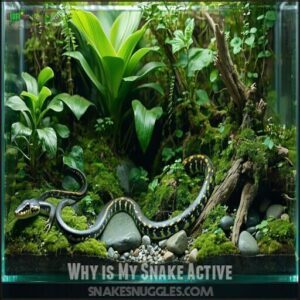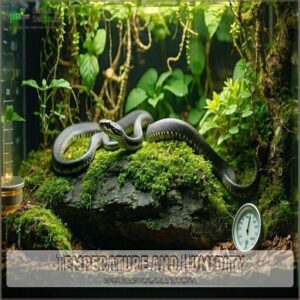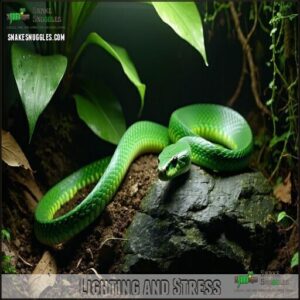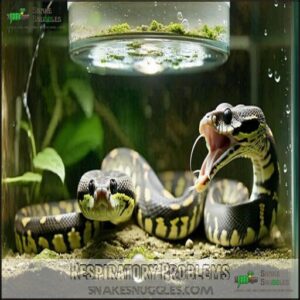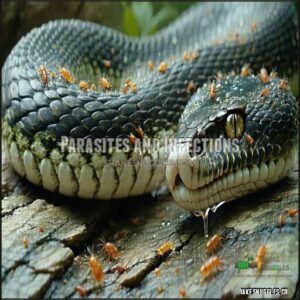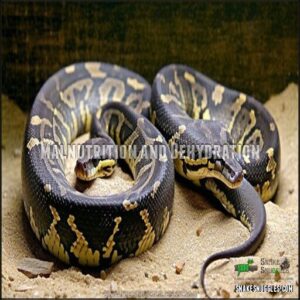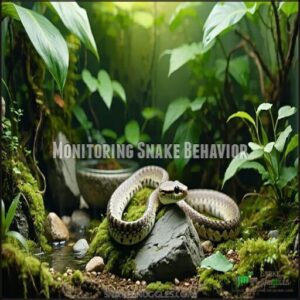This site is supported by our readers. We may earn a commission, at no cost to you, if you purchase through links.
 If you’re wondering, “Why is my snake so active?”, it could be a mix of natural instincts or environmental factors.
If you’re wondering, “Why is my snake so active?”, it could be a mix of natural instincts or environmental factors.
Snakes are most active when searching for food, exploring, or responding to changes in temperature, humidity, or stress. Overly bright lights, a cramped enclosure, or not enough hiding spots might leave them restless.
Sometimes, it’s normal – nocturnal snakes often patrol their tanks at night. But unusual activity could signal health issues, like parasites or malnutrition.
Keep an eye on their behavior and make sure their setup feels safe and cozy. A happy snake is a calm snake—usually!
Table Of Contents
- Key Takeaways
- Snake Activity Levels
- Why is My Snake Active
- Environmental Factors
- Health Issues and Activity
- Monitoring Snake Behavior
- Frequently Asked Questions (FAQs)
- Why is my snake overly active?
- Is an active snake a happy snake?
- Why is my ball python so active but not eating?
- How active should my snake be?
- Why is my snake more active than usual?
- Why do snakes move around so much?
- Why is my corn snake so active?
- Do snakes have a lot of energy?
- How can you tell if a snake is hungry?
- Why do snakes Hiss a lot?
- Conclusion
Key Takeaways
- Your snake might be active due to hunger, stress, or exploring instincts, so check its feeding schedule, enclosure size, and hiding spots.
- Environmental factors like temperature, humidity, and lighting play a huge role in your snake’s behavior—keep settings comfortable and stable.
- Restless activity could signal health issues like parasites or respiratory problems, so watch for symptoms like wheezing, dull scales, or abnormal breathing.
- Snakes naturally have distinct activity patterns; monitor changes in their behavior to distinguish normal exploration from stress or discomfort and identify potential environmental factors.
Snake Activity Levels
You’ll notice that each snake has its own unique activity level, which can change based on factors like temperature, feeding schedule, and breeding season.
Understanding your snake’s normal behavior patterns will help you quickly spot when something isn’t right, whether it’s unusual daytime movement or excessive hiding.
Normal Activity Patterns
How do snakes typically behave in captivity? Most snake species establish predictable activity patterns based on their natural instincts.
Your snake’s normal behavior likely includes periods of rest inside hides, occasional exploration during preferred hours, and active hunting or feeding responses.
Wild activity translates to specific captive norms—ball pythons are naturally nocturnal, corn snakes may be crepuscular, and some colubrids show daytime activity.
Understanding these instinctual actions helps identify when exploration drives are typical versus concerning.
Snakes also use tail movements and vibrations as a form of communication.
Increased Daytime Activity
Sudden daytime activity can feel odd, but it’s often tied to daytime basking, hunting instinct, or new stimuli.
An active snake might be restless due to seasonal variation or exploring enclosure security.
This behavior isn’t always concerning—it could reflect curiosity or minor adjustments in your snake’s routine.
Watch for changes in snake behavior that stray from its normal patterns, which may indicate a need to review your snake’s environment or habits, considering factors like seasonal variation.
Nocturnal Behavior
Most snakes, like your pet, are naturally nocturnal creatures. They’ve evolved to hunt during nighttime hours when their prey is active and they’re less visible to predators.
Your snake’s nocturnal behavior includes:
- Active exploration and climbing after sunset
- Increased tongue flicking and sensory investigation at night
- Periods of stillness followed by bursts of movement
Understanding this circadian rhythm helps distinguish normal snake activity from abnormal behavior patterns.
Why is My Snake Active
I’ll help you understand why your snake might be showing increased activity. After observing normal patterns, you’re probably wondering what’s causing this change in behavior.
| Cause | What You’ll Notice |
|---|---|
| Shedding Cycle | Restless movement, rubbing against objects |
| Hunger | Increased exploring, tongue flicking |
| Breeding Season | Persistent searching, especially males |
| Temperature Issues | Moving between areas seeking comfort |
Your snake moving a lot isn’t always cause for concern. Males often show more activity than females due to natural Gender Influence. If your snake exploring turns into restless behavior that doesn’t stop, consider whether it’s approaching brumation signs or feeling insecure about Enclosure Security.
Males may explore more due to natural instincts, but restless behavior could signal brumation or insecurity in their enclosure.
Observing your snake for common signs of stress is essential for their well-being. When snake activity remains unusual for more than a week, a Veterinary Consult is wise, as it can indicate a need for professional advice on snake care and potential health issues.
Environmental Factors
Your snake’s activity level directly responds to its surroundings, with factors like temperature, enclosure size, and lighting playing key roles in its behavior.
You’ll notice changes in your snake’s movements when these environmental elements aren’t properly balanced, much like how you might feel restless when your home is too hot or too cold, which affects your overall activity.
Temperature and Humidity
Keeping a comfortable temperature and humidity gradient is key to calming your snake if it’s restless or hyperactive.
Use these tips:
- Maintain an ideal temperature (88-90°F warm spots).
- Place thermostats near the heat pad for accuracy.
- Adjust humidity seasonally for shedding.
- Use monitoring tools like hygrometers.
- Check heat regularly to confirm proper temperature regulation.
Enclosure Size and Hiding Places
A snake enclosure that’s too small or lacks hiding spots can lead to stress and overactivity.
Verify the snake tank setup has proper enclosure dimensions, at least two hides, and enrichment options like plants or logs.
Hiding spots help with their security needs and stress reduction.
Selecting the right size enclosure is essential, as proper habitat size directly impacts the snake’s well-being.
| Priority | Enclosure Needs | Impact |
|---|---|---|
| High | Proper dimensions | Reduces stress |
| High | Hide placement | Offers security |
| Medium | Enrichment options | Promotes activity |
| Medium | Diverse hiding spots | Keeps snake calm |
| Low | Habitat additions | Enhances exploration |
Lighting and Stress
If your snake seems restless, check the enclosure brightness.
Bright lights, including basking lamps, can trigger snake stress, making them more active than usual.
Snakes prefer dim environments, mimicking their natural hiding habits.
A stable day/night cycle helps maintain snake normal behavior, reducing environmental stress.
Adjust lighting to soothe their light sensitivity and encourage relaxation in their enclosure.
Many owners source appropriate lighting options for their snakes to ensure a comfortable and stable environment, promoting normal behavior.
Health Issues and Activity
Sometimes, your snake’s increased activity could be a sign of an underlying health issue, like respiratory problems or parasites.
It’s important to check for other symptoms, like wheezing, weight loss, or changes in skin condition, and consult a veterinarian if needed.
Respiratory Problems
Increased activity could hint at respiratory problems, a key snake health concern.
Watch for infection signs like breathing difficulty or mucus discharge. Improper humidity impacts respiratory health too.
Here’s what to do:
- Check for abnormal breathing or mouth bubbles.
- Monitor for wheezing or lethargy.
- Maintain proper heat and humidity.
- Seek veterinary advice promptly.
- Follow prescribed medication options carefully, which is crucial for the snake’s overall health.
Parasites and Infections
Noticing unexpected activity? Parasites like mites or internal invaders could stress your pet. Check for Scale Rot, visible worm-like movements, or dull scales.
Bacterial Infections also cause discomfort. Follow strict Quarantine Protocols after treatments. Regular mite identification and a snake veterinary consultation guarantee peace of mind.
If symptoms persist, get veterinarian advice to address snake health concerns promptly.
| Indicator | Possible Cause | Actions to Take | Severity Risk |
|---|---|---|---|
| Dull Scales | Scale Rot | Check humidity/dry scales | Moderate |
| Visible Worms | Internal Parasites | Fecal test by vet | High |
| Erratic Activity | Mites | Clean tank, inspect skin | Medium |
| Labored Breathing | Bacterial Infections | Antibiotics from vet | High |
Malnutrition and Dehydration
Occasionally, an active snake signals malnutrition or dehydration. These issues harm your snake’s health and lead to alarming behaviors.
Watch for:
- Weight loss—your snake should maintain steady weight.
- Water deprivation—always provide fresh water to avoid organ failure.
- Nutrient deficiency—ensure proper supplementation during feeding.
Focus on a balanced snake diet and weight. Ball pythons may show wrinkled skin folds when dehydrated. Monitor these snake health concerns carefully to prevent bigger problems.
Monitoring Snake Behavior
You’ll learn a lot about your snake by paying attention to its behavior, especially when it’s unusually active.
By tracking its movements, feeding habits, and stress signals, you can spot patterns, identify concerns, and guarantee your snake stays healthy and comfortable.
Tracking Activity Levels
Creating an activity log is key to understanding your snake’s increased activity.
Tracking movement patterns lets you establish a baseline and spot long-term trends. When your snake seems restless or hyperactive, consistent behavior analysis helps connect the dots.
Observe changes in snake activity levels closely, as regular snake behavior observation can reveal important insights about their overall health and comfort.
To better monitor your snake’s activity, consider using a snake activity tracker.
Observing Feeding Habits
Pay attention to your snake’s feeding behavior, especially if it seems restless or hyperactive.
Monitor feeding frequency, ensuring prey size matches its needs. Food rejection can signal stress or improper temperatures.
Avoid live feeding—it risks injury and regurgitation issues. Stick to a consistent snake feeding schedule, as irregularity might upset their routine.
Unpredictable feeding habits often lead to unnecessary activity spikes, which can be mitigated by maintaining a consistent schedule.
Checking for Signs of Stress
Spotting signs of snake stress can save you a headache.
Snake hyperactive or restless? Check hiding behavior—is your snake avoiding cover?
Feeding refusal and abnormal behavior, like fast breathing patterns or odd body language, can hint at stress factors.
Examine scale condition for injuries or burns.
Remember, a stressed snake often skips meals and shows unusual habits.
Stress can also manifest as changes in appetite, so monitor feeding closely, as this can be a key indicator of snake stress.
Frequently Asked Questions (FAQs)
Why is my snake overly active?
Your snake’s increased activity could mean it’s too warm, stressed, hungry, or exploring.
Check temperature, humidity, and hiding spots.
Seasonal changes or mating instincts might play a role.
Monitor closely, and adjust the environment to address potential issues related to hiding spots.
Is an active snake a happy snake?
It’s not always happiness; an active snake might be exploring, hunting, or stressed.
Check its enclosure—heat, hiding spots, and humidity matter.
If everything’s fine, they may just be curious. Watch closely for changes.
Why is my ball python so active but not eating?
Your ball python’s activity and lack of appetite might stem from stress, environmental changes, or breeding-related behaviors.
Double-check enclosure temperatures, hiding spots, and humidity levels.
If issues persist, consider consulting a reptile vet for guidance.
How active should my snake be?
Think of your snake like a shy explorer.
It should mostly rest and hide, with short bursts of activity for exploring or hunting.
Excessive movement may signal stress, curiosity, or a need to adjust its habitat.
Why is my snake more active than usual?
Your snake’s increased activity could stem from environmental changes, hunger, or natural instincts like exploring or mating.
Double-check the enclosure’s temperature, hiding spots, and feeding schedule to verify it feels safe and comfortable.
Why do snakes move around so much?
Did you know some snakes can travel up to 12 miles searching for mates.
In captivity, movement often means curiosity, stress, or exploring their enclosure.
Check habitat conditions to keep your snake happy and secure.
Why is my corn snake so active?
Your corn snake’s activity might stem from exploring, hunger, or seeking environmental adjustments.
Verify the enclosure’s temperature, humidity, and hiding spots meet its needs.
Seasonal changes or natural hunting instincts could also play a role, and understanding these factors can help in making necessary adjustments.
Do snakes have a lot of energy?
Snakes aren’t typically high-energy animals, but they can have bursts of activity.
This usually happens when they’re exploring, hunting, looking for mates, or adjusting to their environment.
It’s their way of staying engaged and managing their energy through bursts of activity.
How can you tell if a snake is hungry?
Over 60% of ball python behavior issues stem from feeding routines.
If your snake prowls its enclosure, flicks its tongue more, or shows increased focus near you, it’s probably hungry—time to grab dinner!
Why do snakes Hiss a lot?
Hissing usually means your snake feels threatened or stressed.
It’s their way of saying, “Back off!”
Check their habitat for stress triggers like improper temperature, lack of hides, or recent handling, and adjust as needed to mitigate the stress.
Conclusion
Imagine your snake pacing at odd hours—it could be hunting instincts or stress from a too-bright light.
When asking, "Why is my snake so active?" consider their natural patterns, enclosure setup, and possible health concerns.
A cramped tank or wrong humidity levels might be the culprit, but don’t overlook signs like parasites or malnutrition.
Observe their behavior closely, adjust their environment, and consult a vet if needed.
A thoughtful approach guarantees a healthy, calm snake.
- https://www.tandfonline.com/doi/abs/10.1080/11250009809386744
- https://academic.oup.com/chemse/article/31/6/521/290704
- https://cshperspectives.cshlp.org/content/8/2/a019174
- https://vcahospitals.com/know-your-pet/snakes-problems
- https://ball-pythons.net/forums/showthread.php?159691-my-ball-python-just-finished-shedding-and-is-acting-weird


